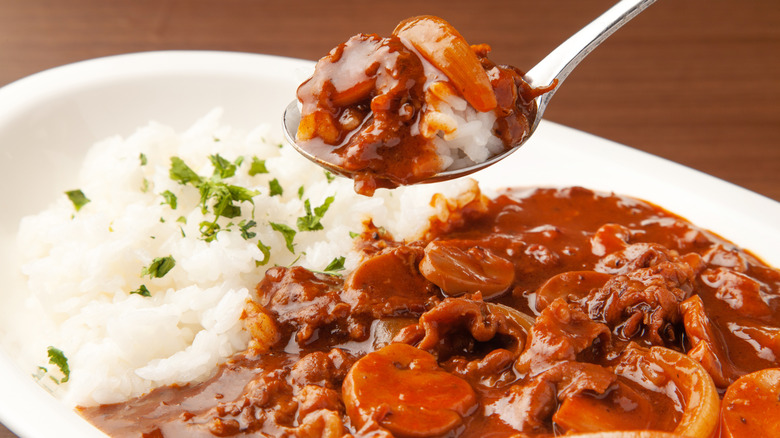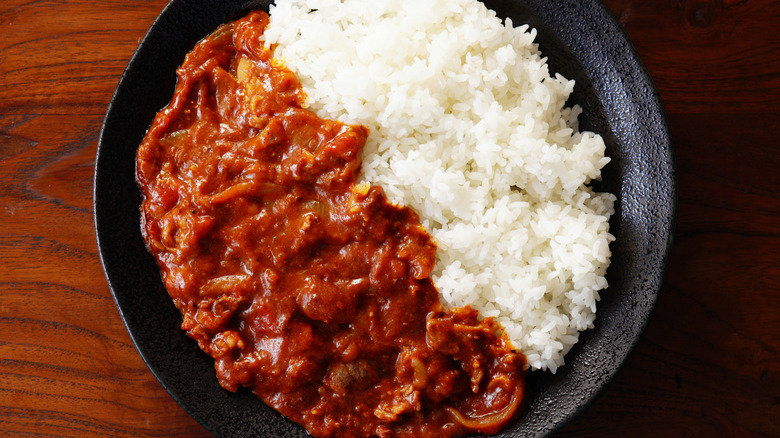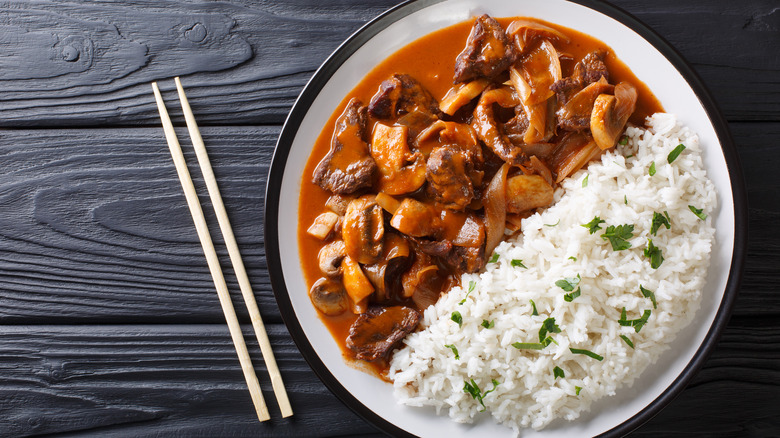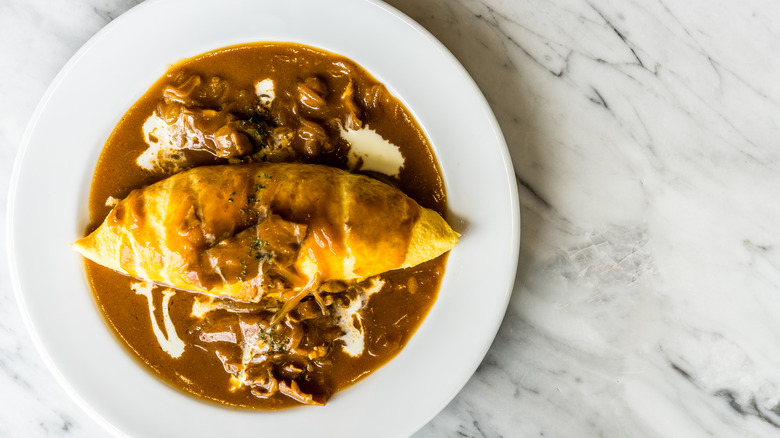Hayashi Rice Sauce Adds A Rich, Umami Finish To Meals
From interpretations of spaghetti to curry rice and tonkatsu, Japanese cuisine includes a selection of Western-influenced dishes. Few bear their influences quite as strongly as Hayashi rice sauce. Made with roux, demi-glace, beef, and mushrooms, the dish is seemingly straight out of a French cookbook. However, the addition of a few ingredients — as well as distinct preparation techniques — make it a uniquely Japanese creation.
Served alongside fresh rice, the sauce has become a modern comfort meal, often purchased in instant form. With an extensive array of flavorings, as well as tricky components like demi-glace, few cooks make it completely from scratch. However, such variability is part of its appeal — there are quite a few Hayashi deviations.
With its savory, salty, and sweet notes amplified by an almost curry-like density, it's easy to see why the sauce has become a modern classic. Let's dive into what the delicious creation is all about.
What is Hayashi rice sauce?
This comforting stew is part of a Japanese food style known as yoshoku. Translated as "Western food," yoshoku is a cooking methodology that reinvents European and American-style dishes with Japanese techniques. Hayashi is an interpretation of French-style demi-glace sauce accompanied by beef and mushrooms. The dish reaches for French components like wine and tomato sauce but reimagines them with Japanese additions such as soy sauce.
While the dish's exact origins are unknown, it likely came about during the onset of the Meiji era. Towards the end of the 19th century, Japan relaxed its isolation and welcomed foreign influence. According to popular belief, Hayashi emerged during this time at the hands of a French engineer. Stationed in a mining town, he introduced demi-glace to the area, where it was soon served with local shaved Kobe beef and rice.
Today, Hayashi rice sauce is enjoyed around Japan, especially in packaged form. A short-cut instant version is a ubiquitous convenience meal — like a French-tinged version of the beloved curry rice. Although tasty, there's nothing quite like crafting it from scratch.
How to make Hayashi rice sauce
The complex sauce integrates quite a few components, lending it a texture reminiscent of curry. Typically, it's prepared in conjunction with the beef and mushrooms — they imbue their flavor into the result. Cooking starts with the preparation of a roux, crafted with flour, butter, and beef stock. Set it aside once it thickens to a dark brown color. A demi-glace may also be prepped ahead of time. However, it's more commonly purchased.
Next, the thinly sliced beef — usually chuck or ribeye — is sautéed on high heat. Although sometimes marinated, typically, the beef is only seasoned with salt and pepper. After a quick sear, the beef is set aside. Utilizing the remaining beef juice in the pan, the Hayashi sauce assembly starts. Butter and olive oil are added to the pan, in which onions and carrots are sauteed. Once they turn translucent, mushrooms are introduced, followed by chopped garlic.
Next comes a varied blending of flavorings, usually red wine, Worcestershire sauce, ketchup, soy sauce, and tomato paste. Some also add a tinge of sweetness through brown sugar and variable spices, including sweet paprika, bay leaf, and cloves. After simmering for a few minutes, the roux is stirred to thicken. However, not all versions employ the thickener — some simply simmer down for longer. With a final salt and pepper seasoning, Hayashi rice sauce is ready to serve.
How to serve Hayashi rice sauce
As evinced by the name, this hearty sauce is usually accompanied by rice. It's typically ladled beside fresh steamed white rice, which is softened with butter. Some also add parsley and garlic to the carb for extra flavoring. Since the sauce is like a liquid stew, other vegetables can be included in the mix, like bell peppers or carrots. And for a Japanese breakfast interpretation, the concoction tops an omelet in a Hayahsi omurice.
While the dish is intertwined with its rice complement, newer renditions layer it onto other foods, too. It goes well with noodles, especially ones utilizing the thicker-cut Taiwan-style variety. Or, to dip even further into the dish's Western inspiration, serve it alongside pasta. With flavors gently balancing influences, it's easy to meld into even more creative interpretations. Craft it into a Japanese-style French dip, or serve it alongside roasted potatoes. Propped by a dense, flavorful consistency, finding an application for Hayashi rice sauce is never a challenge.



